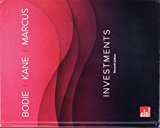
a
Adequate information:
Risk-free Asset E(rp)=11%
sp=15%
rf=5%
Expected
To compute: The proportion of investment in the risky portfolio (P) along with the proportion of risk-free asset.
Introduction:
Capital Allocation Line (CAL): It states the prevailing
Where
E(rc)= Expected return of the portfolio
rf=Risk free rate
y=Proportion invested
E(rp)=Expected return of the risky portfolio
Risk-aversion: It can be described as the preference of sure return or outcome over an investment which has either equal value or even more high value.
b
Adequate information:
Risk-free Asset E(rp)=11%
sp=15%
rf=5%
Expected rate of return or complete portfolio=8%
To compute: The standard deviation of the rate of return related to client’s portfolio.
Introduction:
Capital Allocation Line (CAL): It states the prevailing market equilibrium conditions for various portfolios which consist of both risky and risk-free investment. The formula used to calculate CAL is as follows:
Where
E(rc)= Expected return of the portfolio
rf=Risk free rate
y=Proportion invested
E(rp)=Expected return of the risky portfolio
Risk-aversion: It can be described as the preference of sure return or outcome over an investment which has either equal value or even more high value.
c
Adequate information:
Risk-free Asset E(rp)=11%
sp=15%
rf=5%
Expected rate of return or complete portfolio=8%
To compute: The standard deviations of another client with the condition that limit does not cross more than 12% and compare the risk aversion of both the clients.
Introduction:
Capital Allocation Line (CAL): It states the prevailing market equilibrium conditions for various portfolios which consist of both risky and risk-free investment. The formula used to calculate CAL is as follows:
Where
E(rc)= Expected return of the portfolio
rf=Risk free rate
y=Proportion invested
E(rp)=Expected return of the risky portfolio
Risk-aversion: It can be described as the preference of sure return or outcome over an investment which has either equal value or even more high value.
Want to see the full answer?
Check out a sample textbook solution
Chapter 6 Solutions
Investments, 11th Edition (exclude Access Card)
- The time value of money concept is based on the idea that: A) Money loses value over timeB) Money has the same value over timeC) The value of money increases over time due to inflationD) A dollar today is worth more than a dollar in the future explain.arrow_forwardThe time value of money concept is based on the idea that: A) Money loses value over timeB) Money has the same value over timeC) The value of money increases over time due to inflationD) A dollar today is worth more than a dollar in the futurearrow_forwardWhich of the following is the most appropriate metric for determining a company's profitability?A) Return on Assets (ROA)B) Debt-to-Equity RatioC) Price-to-Earnings (P/E) RatioD) Current Ratio need helparrow_forward
- Which of the following is the most appropriate metric for determining a company's profitability?A) Return on Assets (ROA)B) Debt-to-Equity RatioC) Price-to-Earnings (P/E) RatioD) Current Ratio explain.arrow_forwardWhich of the following is the most appropriate metric for determining a company's profitability?A) Return on Assets (ROA)B) Debt-to-Equity RatioC) Price-to-Earnings (P/E) RatioD) Current Ratioarrow_forwardWhat does the term "liquidity" refer to in financial management?A) The profitability of a companyB) The ease with which an asset can be converted into cashC) The long-term sustainability of a companyD) The company's capital structure helparrow_forward
- What does the term "liquidity" refer to in financial management?A) The profitability of a companyB) The ease with which an asset can be converted into cashC) The long-term sustainability of a companyD) The company's capital structurearrow_forwardWhich of the following is a method for valuing a stock using expected future dividends?A) Net Present Value (NPV)B) Dividend Discount Model (DDM)C) Price-to-Earnings (P/E) RatioD) Internal Rate of Return (IRR) explain.arrow_forwardWhich of the following is a method for valuing a stock using expected future dividends?A) Net Present Value (NPV)B) Dividend Discount Model (DDM)C) Price-to-Earnings (P/E) RatioD) Internal Rate of Return (IRR)arrow_forward
- Which of the following statements is true about a bond's yield to maturity (YTM)?A) YTM is the interest rate that makes the present value of bond payments equal to its current market priceB) YTM is only calculated at the time of purchaseC) YTM does not account for the bond’s coupon paymentsD) YTM is the same as the bond’s coupon rate if purchased at face value need assistant.arrow_forwardSuppose that the exchange rate is $0.92/€. Let r$ = 4%, and r€ = 3%, u = 1.2, d = 0.9, T = 0.75, n = 3, and K = $0.85. 1. What is the price of a 9-month European call? 2. What is the price of a 9-month American call? Please show step by step from the beginning.arrow_forwardWhich of the following statements is true about a bond's yield to maturity (YTM)?A) YTM is the interest rate that makes the present value of bond payments equal to its current market priceB) YTM is only calculated at the time of purchaseC) YTM does not account for the bond’s coupon paymentsD) YTM is the same as the bond’s coupon rate if purchased at face value helparrow_forward
 Essentials Of InvestmentsFinanceISBN:9781260013924Author:Bodie, Zvi, Kane, Alex, MARCUS, Alan J.Publisher:Mcgraw-hill Education,
Essentials Of InvestmentsFinanceISBN:9781260013924Author:Bodie, Zvi, Kane, Alex, MARCUS, Alan J.Publisher:Mcgraw-hill Education,

 Foundations Of FinanceFinanceISBN:9780134897264Author:KEOWN, Arthur J., Martin, John D., PETTY, J. WilliamPublisher:Pearson,
Foundations Of FinanceFinanceISBN:9780134897264Author:KEOWN, Arthur J., Martin, John D., PETTY, J. WilliamPublisher:Pearson, Fundamentals of Financial Management (MindTap Cou...FinanceISBN:9781337395250Author:Eugene F. Brigham, Joel F. HoustonPublisher:Cengage Learning
Fundamentals of Financial Management (MindTap Cou...FinanceISBN:9781337395250Author:Eugene F. Brigham, Joel F. HoustonPublisher:Cengage Learning Corporate Finance (The Mcgraw-hill/Irwin Series i...FinanceISBN:9780077861759Author:Stephen A. Ross Franco Modigliani Professor of Financial Economics Professor, Randolph W Westerfield Robert R. Dockson Deans Chair in Bus. Admin., Jeffrey Jaffe, Bradford D Jordan ProfessorPublisher:McGraw-Hill Education
Corporate Finance (The Mcgraw-hill/Irwin Series i...FinanceISBN:9780077861759Author:Stephen A. Ross Franco Modigliani Professor of Financial Economics Professor, Randolph W Westerfield Robert R. Dockson Deans Chair in Bus. Admin., Jeffrey Jaffe, Bradford D Jordan ProfessorPublisher:McGraw-Hill Education





